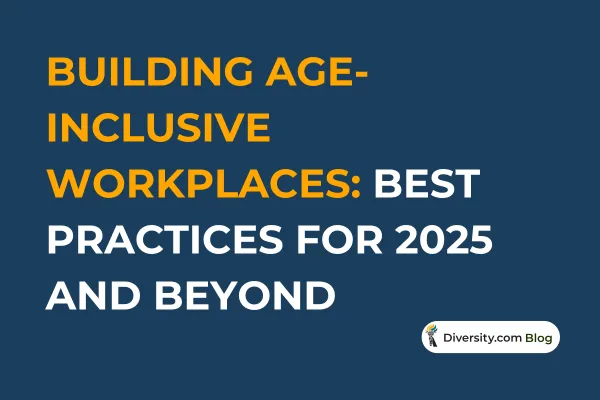
Building Age-Inclusive Workplaces: Best Practices for 2025 and Beyond
After a week of headlines, legislation, and powerful personal stories, one truth is clear: age inclusion is essential to a truly equitable workplace.
As new laws emerge and the workforce spans five generations, employers must move from compliance to real culture change.
Here’s how organizations can build age-inclusive workplaces that attract, support, and retain talent—at every stage of life.
Why Age Inclusion Matters More Than Ever
Ageism doesn’t just hurt individuals—it undermines teams, innovation, and the bottom line. AARP estimates that age discrimination costs the U.S. economy $850 billion each year in lost productivity and turnover (AARP, 2025).
With older workers making up a growing share of the workforce, building age-inclusive cultures is both a business and moral imperative.
Best Practices for Building Age-Inclusive Workplaces
1. Audit and Update Policies for Age Neutrality
Remove age-identifying questions (birth date, graduation year) from job applications and internal forms.
Ensure job descriptions focus on skills, outcomes, and growth—not assumptions about “fit” or “energy.”
Regularly review promotion, retention, and layoff criteria for age bias.
2. Invest in Intergenerational Collaboration
Encourage mentorship and reverse mentorship between generations—pairing experience with fresh perspectives.
Offer team projects that leverage diverse skills and backgrounds.
Celebrate milestone anniversaries and career achievements across all age groups.
3. Support Lifelong Learning and Development
Provide access to reskilling, upskilling, and leadership programs for employees at every career stage.
Highlight success stories of workers who’ve reinvented themselves or taken on new challenges later in life.
4. Foster Flexibility and Support for Caregivers
Offer flexible schedules, remote work options, and caregiver leave policies—benefiting employees caring for children, partners, or aging parents.
Normalize the conversation around caregiving, health, and life transitions.
5. Challenge Stereotypes and Unconscious Bias
Train managers and teams to recognize and interrupt ageist assumptions (“tech-phobic,” “set in their ways,” “overqualified”).
Incorporate age diversity into your DEI strategy and measurement.
Create safe channels for employees to share concerns and stories about age bias.
6. Communicate Inclusion—Year-Round
Celebrate age diversity in internal and external communications.
Spotlight role models and leaders of all ages.
Reiterate that inclusion isn’t just about visible diversity—it’s about experience, perspective, and respect.
Action Steps for Employers and Job Seekers
For Employers: Commit to regular audits, transparent communication, and leadership accountability on age inclusion.
For Job Seekers: Know your rights, seek out organizations with strong age-inclusive policies, and bring your whole experience to the table.
Conclusion
Age-inclusive workplaces are not just a response to new laws—they’re a commitment to harnessing the wisdom, energy, and creativity of every generation.
When organizations get this right, everyone benefits: innovation grows, teams thrive, and talent flourishes at every age.
How Diversity.com Supports Inclusion and Safe Workplaces
At Diversity.com, we know true inclusion is more urgent than ever. Outdated systems and new legislation should never stand in the way of opportunity or safety.
We are committed to helping job seekers and employers connect in a space built on authenticity, respect, and real DEI leadership.
As the leading DEI job board, we provide the tools and resources you need to navigate today’s challenges and build a future where everyone belongs.
For Employers & HR Leaders:
✔ Post Inclusive Job Listings — Reach a diverse, talented pool of candidates and show your commitment to workplace equality—even in challenging times.
✔ Access Up-to-Date DEI Resources — Get the latest guidance on responding to new state laws, updating your policies, and supporting all employees with confidence.
✔ Build a Resilient Community — Connect with other professionals facing similar challenges, share strategies, and lead the way on real inclusion.
For Job Seekers:
✔ Find Safe and Inclusive Employers — Explore organizations actively supporting inclusion, even as laws and climates shift.
✔ Strengthen Your Profile — Showcase your experiences and find employers who value diversity, equity, and your authentic self.
✔ Stay Informed & Empowered — Access timely articles and resources about your rights, workplace safety, and strategies for thriving—no matter where you work.
We believe every job search and every hire can help create safer, more inclusive workplaces.
Ready to take action? Start building with Diversity.com.
If you have any questions or need assistance, feel free to Contact Us Here. Our dedicated support team is ready to help!
Related Articles
Debunking the Myth: DEI Doesn’t Mean Lowering Hiring Standards
Real Stories, Real Impact: Older Workers Speak Out on Ageism in 2025
What Employers Need to Know About the Protecting Older Workers Against Discrimination Act (POWADA)
Ageism in the Workplace: Key Lessons from 2025’s New Developments
Summer Internship Season: Best Practices for Diversity and Inclusion in Internship Programs
Sources & References
AARP. (2025). Fighting age discrimination in the workforce. https://www.aarp.org/politics-society/advocacy/info-2025/fighting-age-discrimination-in-workforce.html

